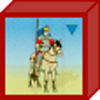Historical Background
Julius Caesar crossed the Adriatic with seven depleted legions in order to confront Gnaeus Pompey’s main army and bring the civil war to an end. Antony, with the remaining five legions, was delayed (see Brindisi Raid). Caesar followed Pompey to Asparagium and boldly offered battle but Pompey refused, in spite of numerical superiority, because his troops were much inferior in training to Caesar’s veterans. Meanwhile, Antony, blown far off course, had crossed the Adriatic and landed in Pompey’s rear. Pompey, presented with the opportunity to destroy his opponents in detail, was obsessed instead about being trapped between them. Caesar moved quickly to join Antony and simultaneously threaten Dyrrhachium, Pompey’s logistical base. Pompey marched to defend it, but Caesar joined Antony and occupied Dyrrhachium first. Caesar audaciously began blockading Pompey’s larger army against the sea by constructing a line of forts. Pompey retaliated with his own line of counter-fortifications. Pompey’s larger army began running short of supplies and (more importantly) water. He was left with no choice but to attack or surrender. He finally decided to break Caesar’s line at the southern end of the fortifications, where Caesar’s ramparts were not quite complete. Pompey’s plan was excellent, as he landed a contingent of marines and light troops from the sea and at the same time stormed across the river with several of his best legions toward Caesar’s weak point in his line. The defenders held for some time against this combined force, but finally were pushed back. Anthony’s arrival stopped the advance, but Pompey’s troops threw back Caesar’s vastly outnumbered veterans as they counterattacked to retake their lines. Pompey built a new camp near the shore that secured access for his large cavalry arm to the grazing lands to the south. Caesar, desperately short of supplies himself, was forced to withdraw. His army moved into Thessaly, pillaging as they went, and regaining strength. Pompey warily pursued his rival. Caesar consoled his troops afterward, telling them it was not lack of fighting prowess, but rather fate and circumstance that defeated them. His army’s morale remained high, and they were most eager to avenge their defeat. Pompey’s troops and the host of Senators accompanying the army began to see themselves as more than a match for Caesar and his veterans. It was this fatal overconfidence that compelled them to advance and do battle later at Pharsalus.
The stage is set. The battle lines are drawn and you are in command. The rest is history.

 |
 |
 |
 |
 |
 |
 |
 |
||||||||||||
| 1 | 2 | 1 | 7 | 2 | 1 | 1 | 2 | ||||||||||||
 |
 |
 |
 |
 |
 |
 |
|||||||||||||
| 1 | 2 | 1 | 3 | 5 | 1 | 3 |
War Council
Pompeian Army
• Leader: Pompey
• 5 Command Cards ![]()
![]()
![]()
![]()
![]()
• Move First ![]()
Caesarian Army
• Leader: Caesar
• 5 Command Cards ![]()
![]()
![]()
![]()
![]()
Victory:
6 Banners
Special Rules
• Julian Legions rule is in effect for both armies.
• Julius Caesar Rule is in effect.
• A Pompeian unit that exits off the Roman left section of the battlefield counts as one Victory Banner. The unit is removed from play, and may not re-enter.
